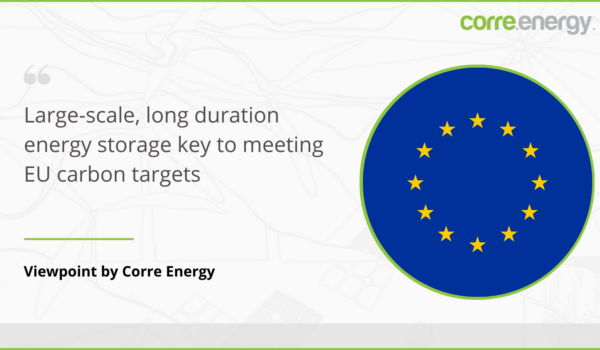Corre Energy welcomes the European Commission’s proposal underscoring the pivotal role energy storage will play in the EU’s energy future. The European Commission recently published its recommendation for a 90% greenhouse gas (GHG) emission reduction by 2040. The target is based on a recommendation by the European Scientific Advisory Board for Climate Change to reduce emissions between 90 and 95% by 2040.
According to the Commission document, wind and solar will dominate the electricity grid by 2040. However, due to their inherent intermittency, this necessitates reliable storage solutions. Long Duration Energy Storage (LDES) technologies like Compressed Air Energy Storage (CAES) will emerge as pivotal solutions under such scenarios. Corre Energy’s CAES facilities in Germany, the Netherlands and Denmark are designed to store excess renewable energy during periods of overproduction and release it during peak demand, thereby facilitating the transition to net-zero emissions while ensuring energy security and lower prices for consumers.
Corre Energy particularly welcomes the explicit recognition of energy storage as indispensable in achieving the decarbonisation of the energy system by 2040. Member State policy is now also moving in the right direction, by creating a marketplace for non-fossil flexibility via LDES. Italy is leading the way in developing an LDES market, with Terna, an Italian Transmission System Operator (TSO) expected to launch an LDES support scheme later this year. Ireland on the other hand recently consulted on the development of an LDES policy, while Germany has stated that its capacity market will be ‘technology neutral’, opening the door to companies such as Corre Energy to participate. Elsewhere, the United Kingdom is also consulting on the implementation of a ‘cap and floor’ mechanism for LDES technologies.
Corre Energy firmly stands behind this science-based target, recognising its alignment with the emissions trajectory outlined in the EU Climate Law. By establishing clear and ambitious goals, it not only reaffirms the EU's commitment to combating climate change but also motivates Member States to redouble their efforts towards achieving the 2030 and 2050 climate objectives.
Recently, Commissioner for Climate Action Wopke Hoekstra stressed the importance of investing in the EU electricity grid during a hearing with Members of the European Parliament (MEPs). With electricity set to double as a share of final energy consumption by 2040, and the grid set to be dominated by variable, weather dependent renewable technologies, investments in the EU’s grid are expected to rise to €650 billion by the end of this decade.
In presenting the 2040 climate target and setting an ambitious GHG emission reduction target, the EU reaffirms its role as a global leader in climate change mitigation. The policies underpinning this objective will attract investments crucial for deploying renewables which will thus need to be balanced by multi-day storage technologies. Corre Energy stands ready to ensure a balanced grid with lower prices for consumers through our projects.


